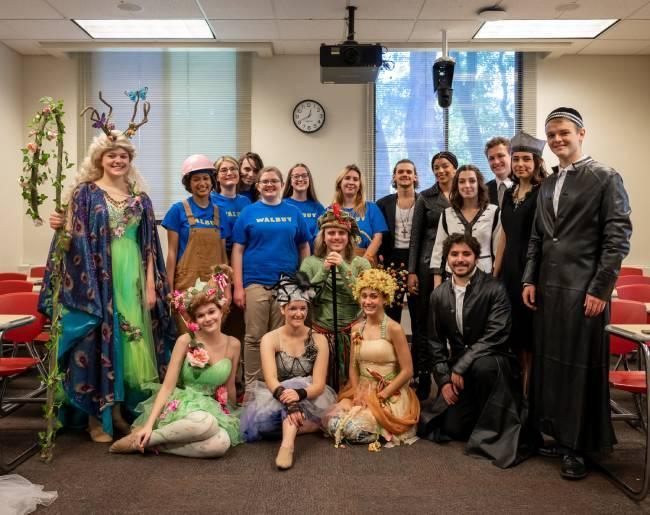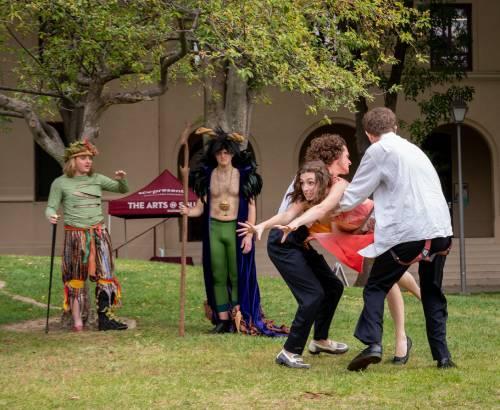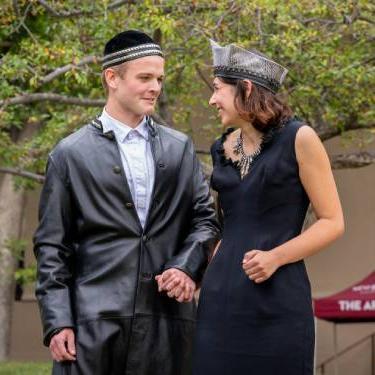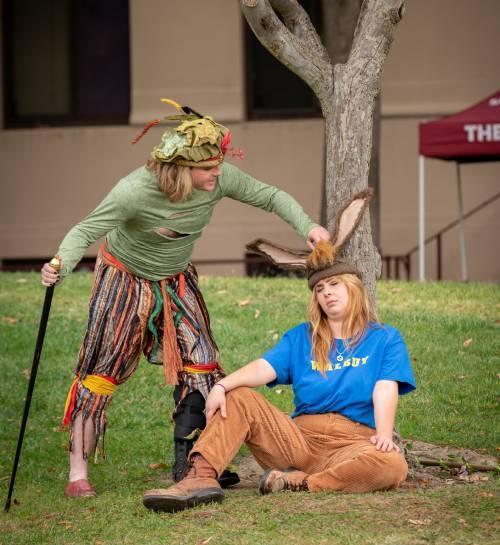
Reimagining Live Theatre during the Pandemic
After many months without live theatre performances on campus, SCU students performed A Midsummer Night’s Dream with a Covid-friendly twist.
By Sarah Stoddard '23
On a Saturday afternoon in November during fall quarter of 2021, I attended Santa Clara University’s performance of A Midsummer Night’s Dream. Due to the Covid-19 pandemic, it had been over a year since I had seen any sort of live performance, and I was incredibly excited to be in the audience once again. The play was remarkable in several ways, the most impressive of which being that it wasn’t performed on a stage in a theatre—instead, the actors used the lawn outside the Louis B. Mayer Theatre as a stage and the surrounding trees and buildings as wings to emerge from. These students, for whom performing is an essential part of their lives, embraced the challenges of this experience to bring back live theatre to the SCU community.

Juliet Kulusic ’23 (Theatre Arts and Psychology), who played the character Bottom, found performing outside to be a rewarding and unique experience. “I joked and said to my director, Aldo Billingslea (Theatre and Dance), I would never act inside again,” she says. “Not only was this the first time in nearly two years I had performed live but, of course, we were outside, staring into the hearts and eyes of the audience and feeling their laughter in such close proximity: it was absolutely incredible.” This experience was, of course, quite different from performing on a typical stage. Olivia Esteban ’22 (Theatre Arts), who played Hermia, explains, “It was honestly kind of overwhelming to be a part of such a big production with so many people after only performing by myself in my room online.” Additionally, everyone wore masks during all rehearsals leading up to the performance. “I didn't really see what anybody in the cast looked like until the day before we opened,” Esteban says.
Alongside all the advantages, there were also many challenges during this experience, in addition to the obvious difficulties of rehearsing and performing during a pandemic. “I would say the biggest drawback is, despite how it feels, the world definitely doesn’t stop while you perform,” Kulusic explains. “Truly doing the experience outside, we invited trains, planes, and automobiles into our show. But it totally increased the theatricality and reminded us of the fragility of us being there.” Luckily, the actors didn’t have to deal with any bad weather.

William Webb ’22 (Theatre Arts), who played the roles of Theseus and Oberon, explains the challenges of running and dancing across the grass and hills of Mayer Lawn. “We suffered one major medical loss in the form of actor Patrick Ocock’s ’22 (Theatre Arts) ankle health—a result of the hazards of nighttime outdoor rehearsals,” he says. A couple of others sustained similar injuries but recovered, and Ocock was able to adapt his performance with the help of Dance Captain Maggie Bannan ’23 (English, Political Science) and Choreographer Leandro Damasco (Theatre and Dance). “Our entire company was deeply heartened and relieved to see the excellent new show the three of them were able to craft out of a less-than-ideal scenario,” Webb says.
After so long without being able to perform, students were more than willing to face and overcome these challenges so they could return to doing what they loved. The pandemic merely served as a reminder of how passionate they are about theatre and of just how important the performing arts are for the community. “It was like having life breathed into you again,” Kulusic says, explaining the feeling of being in front of an audience after so long. “And I know that’s absurdly dramatic, but hey, there’s a reason I do theatre. Being able to feel and hear the audience (their suspense, laughter, and joy), experiencing the journey of Midsummer together was ridiculously rewarding. I will never take this art for granted again.”

Both the performers and members of the larger Santa Clara community benefit from the experience of live theatre. As I sat in the audience during the show, I could feel that everyone understood the tragedy and fragility of the current situation amidst the pandemic, yet everyone equally understood the necessity of connecting with the community through the arts. “Every step of our production was uncertain but we navigated them all, together, with resounding success,” Webb explains. Esteban says, “I think that the arts are a really important part of any community because they cultivate empathy. With live theatre, everyone is in the same place, being a part of the same moments. It brings people together by design.”